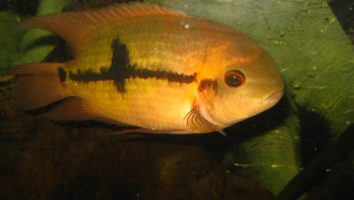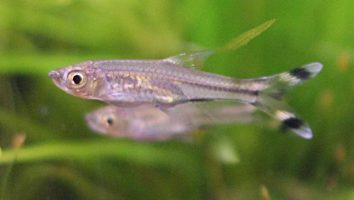The barred-tail corydoras is a stunning freshwater fish that is perfect for beginner aquarists. This species is very peaceful and can be kept with a wide variety of tank mates. They are also very easy to care for, making them a great choice for those new to the hobby.
This guide will teach you everything you need to know about barred-tail corydoras care. You’ll learn about their diet, size, lifespan, and more!
Table of contents
Species overview
Barred-tail corydoras (Corydoras barthi) are a small species of freshwater fish that are native to Peru.
They are found in a wide variety of habitats, but prefer areas with slower moving water and plenty of vegetation. This is something to keep in mind when setting up their tank.
In the wild, these fish are mostly omnivorous, but have a diet that is skewed more toward plants. This is something to keep in mind when choosing their food, as you’ll want to make sure they have a good mix of plant matter and other nutrients.
Barred-tail corydoras are a popular choice for many freshwater aquariums due to their small size and peaceful nature. They are compatible with a wide variety of tank mates and make a great addition to most community tanks.
Appearance

As the name implies, this species has a black “bar” running vertically down the center of their caudal peduncle (the area right before their tail fin).
This is a small but stocky fish that only reaches about 2.5 inches (6.4 cm) when fully grown.
The body of the Barred-tail Corydoras is mostly a brownish color with some black markings. These black markings include the aforementioned bar on their tail as well as some spots on their dorsal, caudal, and anal fins.
The pectoral fins of this fish are clear and have a very long ray. These fins are used for steering and braking more than anything else.
The dorsal, caudal, and anal fins are all short and round. The dorsal fin has 7-9 soft rays while the anal and caudal fins each have 5.
These fins are used more for stability than anything else.
The mouth of the Barred-tail Corydoras is located on the underside of their head and points downwards. This is due to the fact that they’re a benthic species (meaning they spend most of their time near the bottom of the tank).
Lifespan
The average lifespan of a barred-tail corydoras is around 5 years. However, there have been reports of these fish living for up to 8 years in captivity.
As with any other fish, the lifespan of a barred-tail corydoras can be impacted by a number of factors. Things like water quality, diet, and stress can all shorten their lifespan.
Size
The maximum size of a Barred-tail corydoras is about 2.5 inches in length when fully grown.
Tank
Tank Size
The minimum tank size for keeping a school of 5 to 7 Barred-tail corydoras is a 20 gallon long aquarium. If you want to keep a larger school you will need a bigger tank. For example, a 30 gallon long aquarium can comfortably house a school of 10 to 12 fish.
Corydoras are a schooling fish, which means they do best when kept in groups. We recommend a minimum of 5 fish but ideally you should have 7 or more. The more fish you have the more comfortable they will be and the more likely they are to shoal (swim in a group).
Water Parameters
The barred-tail corydoras is a tropical fish that requires warm water to thrive. This is a fish that comes from fast-moving rivers and streams. They’re used to lots of water movement and plenty of dissolved oxygen.
To replicate these conditions in your home aquarium, you’ll need to maintain the following water parameters.
- Water temperature: 72 to 79 degrees Fahrenheit
- pH levels: 6.5 to 7.5
- Water hardness: 2 to 12 dGH
- Alkalinity Levels: 4-8 dKH
What To Put In Their Tank
Corydoras are a very peaceful species of fish, so it’s important to provide them with an aquarium that reflects that.
First and foremost, the substrate should be soft and sandy. These fish spend a lot of time snuggling up against the bottom of the tank and a rough substrate can damage their delicate skin.
You should also include some plants in their habitat. Corydoras are known to nibble on vegetation so you’ll want something that can bounce back (Hornwort, Water Wisteria, or Java Moss are all great choices).
Don’t go overboard when adding wood to their tank. One or two solid pieces if you have a 100-gallon tank should be fine. If you’re keeping them in something significantly larger feel free to add more though!
You can also add some rocks to their tank. Be sure to avoid anything too sharp or jagged since these fish are known to bump into things. A few smooth, rounded rocks will help add some visual interest to their home.
Common Diseases
These little guys are actually quite hardy and don’t usually fall ill. However, there are still a few things you’ll want to keep an eye out for.
The most common disease you’ll see in these fish is ich. This is a parasite that will attach itself to your fish and start feeding off of them. It’s not usually fatal, but it can make your fish very uncomfortable.
The best way to treat ich is to raise the temperature of your tank by a few degrees. This will speed up the life cycle of the parasite and cause it to fall off of your fish sooner.
You can also use a commercial ich treatment, but be sure to remove any carbon from your filter first. Carbon will remove the medication from the water before it has a chance to work.
The other disease you might see is bacterial infection. This is usually the result of a wound or cut that gets infected. The best way to treat this is with a course of antibiotics from your vet.
You can also use a commercial antibacterial treatment, but again, you’ll need to remove the carbon from your filter first.
Behavior & Temperament
The Barred-tail corydoras is a peaceful, social fish that does best when kept in groups. They are shy fish that prefer to stay in hiding during the day, but they will become more active at night. These fish are bottom-dwellers and love to sift through the substrate in search of food.
They are gentle fish that get along well with other peaceful fish. However, they can be bullied by more aggressive fish. If they are kept in a tank with larger fish, make sure there are plenty of hiding places for them to escape to.
Tank Mates
When looking for tank mates for a barred-tail corydoras, you should start by finding other peaceful bottom-dwellers. These fish occupy the same space in the aquarium, so it’s important that they get along.
Corydoras are a great example of a species that does well with others. They’re social by nature and love to hang out in groups. As a result, they make great community fish.
Some good tank mates for a barred-tail corydoras include:
- Tetras
- Guppies
- Mollies
- Platies
- Swordtails
- Endler’s Live Bearers
- Khuli Loaches
- Otocinclus Catfish
- Bristlenose Plecos
Breeding
The first thing you need to do when breeding barred-tail corydoras is to set up a breeding tank. This should be a separate tank from the one where your fish are currently living. The breeding tank should be at least 10 gallons in size.
Barred-tail corydoras are egg-layers. The female will lay her eggs on a smooth surface, such as a piece of slate or glass. Once the eggs have been laid, the male will fertilize them.
The eggs will hatch in about four days. Once they hatch, you can remove the adults from the tank. The fry will live off of their yolk sacs for the first few days. After that, you can start feeding them baby brine shrimp or crushed-up flake food.
As they grow, you can gradually start feeding them larger foods. Keep in mind that corydoras are bottom-feeders, so make sure to offer them food that sinks to the bottom of the tank.
Conclusion
The Barred-tail Corydoras is a beautiful and unique freshwater fish that is perfect for the beginning aquarist. They are easy to care for and get along well with other community fish, making them a great addition to any tank.
These fish are also very active and love to explore their surroundings, so we recommend getting a tank that is at least 20 gallons.
Overall, we think the Barred-tail Corydoras is a great fish for anyone looking to add something new and exciting to their tank!












